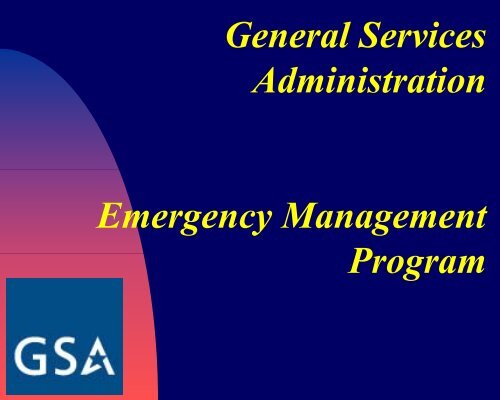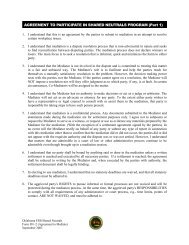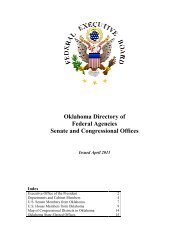Presidential Decision Directive 67 - Oklahoma Federal Executive ...
Presidential Decision Directive 67 - Oklahoma Federal Executive ...
Presidential Decision Directive 67 - Oklahoma Federal Executive ...
Create successful ePaper yourself
Turn your PDF publications into a flip-book with our unique Google optimized e-Paper software.
General ServicesAdministrationEmergency ManagementProgram
GSA EmergencySupportThe Basic Mission does not change duringPeacetime or Wartime EmergenciesDuring emergency conditions ourmission is to provide rapid and efficientlogistical and telecommunications support tothose <strong>Federal</strong> agencies assisting victims ofdisasters or emergencies.
The MissionEnsure GSA’s continuity of operationsLogistical and telecommunications supportAssist client agency recovery
<strong>Executive</strong> Orders12656 & 12472Assignment of Emergency PreparednessResponsibilities
<strong>Executive</strong> Order 12656 Develop plans and procedures for :Operating and maintaining <strong>Federal</strong>lyowned and occupied buildingsConstructing, acquiring, repairing,prioritizing occupancy of <strong>Federal</strong> realproperty by <strong>Federal</strong>, state and localagenciesOperating the government-wide supplyprograms
<strong>Executive</strong> Order 12656Continue Develop plans and procedures for :Use of excess and surplus <strong>Federal</strong> real andpersonal propertyPromoting a government-wide program tominimize the effects of attack on <strong>Federal</strong>buildings and propertyEstablishing a government-wide shelterprogram in <strong>Federal</strong> facilities
<strong>Executive</strong> Order 12472Establishes the National CommunicationSystem (NCS)Managed by the Office of Science andTechnology PolicyConfederation of <strong>Federal</strong> departmentsand agencies and TelecommunicationIndustry Representatives
<strong>Executive</strong> Order 12472ContinueEnsure that <strong>Federal</strong>ly owned ormanaged domestic communicationsfacilities and services meet the nationalsecurity and emergency preparednessrequirements of the <strong>Federal</strong> civiliandepartments, agencies and entities.
<strong>Presidential</strong> <strong>Decision</strong><strong>Directive</strong> <strong>67</strong>PDD <strong>67</strong> provided GSA with several challengingopportunities:• Coordinate with FEMA to develop and conduct aplan to issue periodic guidance to the federalfamily in the form of a <strong>Federal</strong> PreparednessCircular;• Conduct training for department and agencies, toensure that they comply with the requirementsand objectives of the COOP directives;
<strong>Presidential</strong> <strong>Decision</strong><strong>Directive</strong> <strong>67</strong>• Develop and implement a plan that will ensure alldepartments and agencies identify requiredalternate facilities to support the COOPrequirements;• In coordination with DOD develop a plan andmechanism for collecting, maintaining, anddistributing a database of Continuity ofOperations (COOP).
<strong>Presidential</strong> <strong>Decision</strong><strong>Directive</strong> <strong>67</strong>• Ensure that a national inventory ofalternate facilities is maintained, updated,and resolve conflicts; approve standardsand procedures for site searches andselection, and archiving information asassisted by DOD.
Emergency ManagementProgram GSA Order ADM P 2400.18Domestic EmergenciesFires, Earthquakes, Winter Storms and Ice,Flooding, Hurricane, Epidemics, HighlyContagious Animal Disease, Drought,Energy and Fuel, Hazardous MaterialRelease, Radiological Accident, DamFailures, Explosion, Volcanic Eruption,Tsunami, Emergency Repatriation,
Emergency ManagementProgram GSA Order ADM P 2400.18National Security Emergencies War, Limited War, Conventional,Insurrection, Sabotage, Nuclear, Chemicaland Biological, Terrorism, Weapons ofMass Destruction
Emergency Plans/AgreementsNational Communications SystemNational Plan for Telecommunications Supportin Non-wartime Emergencies and MajorDisaster<strong>Federal</strong> Emergency Management AgencyMemorandum of Understanding<strong>Federal</strong> Radiological Emergency<strong>Federal</strong> Response PlanNATO Civil Emergency Planning
Emergency Plans/AgreementsSmall Business AdministrationMemorandum of Understanding Small Business Act - Authority to declarea disasterDepartment of Human and HealthServices National Emergency RepatriationPrimarily a wartime plan National Disaster Medical System
Emergency Plans/AgreementsDepartment of JusticeOperating Plan for Threat or AttackAgainst a Nuclear Facility Mass Immigration Emergency Plan Operating Plan for Civil Disturbances Operating Plan for <strong>Federal</strong> PrisonDisorders
Emergency Plans/AgreementsEnvironmental Protection AgencyMemorandum of UnderstandingNational Contingency PlanResponsible for U.S. landUnited States Coast Guard Memorandum of UnderstandingNational Contingency PlanResponsible for U.S. navigable waterwayor seas.
Emergency Plans/AgreementsUnited States Department of Agriculture,Animal Health and Plant Health InspectionServiceMemorandum of UnderstandingNational Emergency Response to HighlyContagious Animal DiseaseDepartment of Defense Memorandum of UnderstandingAssist with the COOP Alternate FacilityDatabase
EMERGENCYSUPPORT FUNCTION 7HOW IT WORKS
BACKGROUNDFEDERALRESPONSE PLAN(FRP)
Emergency SupportFunctionsESF ANNEX PRIMARY AGENCY12345<strong>67</strong>89101112TransportationCommunicationsPublic Works & EngFirefightingInformation & PlansMass CareResource SupportHealth & Medical SvcsUrban Search & RescueHazardous MaterialsFoodEnergyDept of TransportationNational Communications SysDOD, Corps of EngineersDept of AgricultureFEMARed CrossGSAHHS, U.S. Public HealthDepartment of DefenseEPADept of AgricultureDept of Energy
ESF #7 - RESOURCE SUPPORTSpaceManagementSecurity & LawEnforcementTravel &TransportationServicesProcurementSectionPersonnelResourceTelecommunicationsServicesFleetManagement
Type of Support Provided<strong>Federal</strong> Supply ServiceUnlimited contracting officersTravel and Transportation Services Property ManagementDisposition of excess and surplus personalpropertyDonation, Sale, Utilization Supply and ProcurementFleet Management
Type of Support Provided<strong>Federal</strong> Technology ServiceTelecommunications Services Priority SystemLocal ServicePurchase of Telecommunications Service(POTS)Information Security Services &Telecommunications Support ContractSpecial Arrangements
Type of Support ProvidedPublic Building ServiceRealty SpecialistLease SpaceConstructionBuilding MaintenanceProperty ProtectionContract Guards<strong>Federal</strong> Police/Mobile Command VehiclesMake available excess and real property
SPACEMANAGEMENT*Disaster Field Office (DFO)*Disaster Recovery Centers (DRC)*Warehouses*Mobilization Centers (MOB)
TRAVEL &TRANSPORTATIONSERVICESESF 7 provides a full range of transportationservices for:• Personnel travel or relocation services,• Freight transportation assistance.• Vehicles for long or short term use.
MOBILIZATION CENTER (MOB)The United States Forest Service operatesthe interagency operation of the MOBCenters.The services of the MOB center areavailable to any ESF or <strong>Federal</strong> agencysupporting a disaster response.
PROCUREMENT SECTIONESF 7 Leader directs the procurement activities.Contracting officers receive and monitor all taskrequests for ESF 7 with the assistance ofadministrative support personnel.Contracting Officers have unlimited and generalwarrant to perform contracting and purchasing forthe ESFs.
LAW ENFORCEMENT & SECURITYFEMA Security Division assumes the role of theSecurity & Law Enforcement Liaison Point Of Contact(POC).The function will be supported by the <strong>Federal</strong>departments and agencies with law enforcementassets, and will operate in conjunction with thedesignated State POC for law enforcement.
Emergency Response Team - NationalLaw Enforcement & Security TeamLE&ST is composed of <strong>Federal</strong> Police Officers fromRegions 2, 3, 4, 7, 8 & NCR.A subordinate element of ESF#7Activated by the GSA Emergency Coordinator uponrequest from FEMADeployed within 6 hours of notification of a major orcatastrophic event.May be deployed with Mobile Command Units.Reports to the ESF #7 Leader upon arrival.
EMERGENCYTELECOMMUNICATIONSSERVICESDuring a disaster, when ESF 2 is not activated, aGSA telecommunications specialist will deploywith ESF 7 team to provide telecommunicationscoordination for the Disaster Field Office (DFO)and FEMA disaster facilities.
EMERGENCY RESPONSE TEAM(ERT)“A” PERSONNELESF 7 LeaderAdministrative AssistantRealty Specialist(s)Contracting Officer(s)Telecommunications Manager(s)<strong>Federal</strong> Protective Service RepresentativeMobilization Site Manager
ESF #7 SUPPORT AGENCIESDODDOLDOEUSDATREASDOCNCSDVAFEMADOTDOL: Department of LaborDOD: Department of DefenseDOC: Department of CommerceUSDA: Department of AgricultureDOT: Department of TransportationOPM: Office of Personnel ManagementDVA: Department of Veterans AffairsNASAOPMDOE: Department of EnergyTREAS: Department of TreasuryNCS: National Communications SystemFEMA: <strong>Federal</strong> Emergency ManagementAgencyNASA: National Aeronautics and SpaceAdministration
ERT- N PERSONNELRegional Emergency CoordinatorsTraffic & Transportation ManagerContracting OfficersNational Defense <strong>Executive</strong> ReservistSupport AgenciesEmergency Management StaffIncident Commanders/ <strong>Federal</strong> Protective OfficersCommunications TechnicianComputer TechnicianSupport Staff
<strong>Executive</strong> Order 12656,<strong>Presidential</strong> <strong>Decision</strong><strong>Directive</strong>sandContinuity of OperationsPlanningGSA EMERGENCY MANAGEMENT OFFICE
Historical BackgroundIn the beginning……..The White Housecreated<strong>Executive</strong> Order 12656GSA EMERGENCY MANAGEMENT OFFICE
Historical BackgroundE.O. 12656 assign national securityemergency preparedness responsibilities to<strong>Federal</strong> departments and agencies.GSA EMERGENCY MANAGEMENT OFFICE
Historical BackgroundThe Changing ThreatOLD• Single (Soviet)• Survival at Stake• Known• Deterrable• Strategic Use of Nukes• Overt• Europe-Centered• High Risk of EscalationNEW• Diverse• American Interest at Stake• Unknown• Non-Deterrable• Terrorist Use of WMDs• Covert• Regional, Ill-Defined• Little Risk of EscalationGSA EMERGENCY MANAGEMENT OFFICE
Historical BackgroundAfter the <strong>Oklahoma</strong> City bombing, arenewed emphasis in COOP Activities• New threat paradigm: WMD and asymmetricthreats• PDD 39 Counter-terrorism, 6/95• PDD 62 Terrorism, 5/98• PDD 63 Critical Infrastructure Protection, 5/98• PDD <strong>67</strong> Continuity of Operations, 10/98GSA EMERGENCY MANAGEMENT OFFICE
PDD 62 Overview<strong>Presidential</strong> <strong>Decision</strong> <strong>Directive</strong> 62PDD 62 was designed to improve our responsecapability to fighting terrorists.PDD 62 created a systemic approach tofighting terrorism. It clarified agency counterterrorismprograms, increased transportationsecurity, enhanced response capabilities,improved apprehension and prosecutioncapability.GSA EMERGENCY MANAGEMENT OFFICE
PDD 63 Overview<strong>Presidential</strong> <strong>Decision</strong> <strong>Directive</strong> 63•On May 22, 1998, the President ordered thestrengthening of the nation's defenses againstemerging unconventional threats to theUnited States to include those involvingterrorist acts, weapons of mass destruction,assaults on our critical infrastructures, andcyber-based attacks.GSA EMERGENCY MANAGEMENT OFFICE
PDD 63 Overview<strong>Presidential</strong> <strong>Decision</strong> <strong>Directive</strong> 63Major Elements of the critical infrastructureencompasses the following essential assetcategories:Telecommunications and telephonyInformation technologyBanking and FinanceEnergyTransportation Physical infrastructureGSA EMERGENCY MANAGEMENT OFFICE
PDD 66 Overview<strong>Presidential</strong> <strong>Decision</strong> <strong>Directive</strong> 66The Encryption Policy <strong>Directive</strong> (PDD-66)calls for a national-level effort that assuresthe law enforcement community, understrictly defined legal procedures, access toplain text of criminally relatedcommunications and stored information.GSA EMERGENCY MANAGEMENT OFFICE
Introduction of PDD <strong>67</strong>In October of 1998, PDD <strong>67</strong> wasintroduced.PDD <strong>67</strong> became the foundation for otherterrorist-related PDD’s and FPC’s.The triad of interrelated policies andprograms (62, 63 & <strong>67</strong>) enhance thecredibility of our overall national securityposture.GSA EMERGENCY MANAGEMENT OFFICE
PDD <strong>67</strong> Overview<strong>Presidential</strong> <strong>Decision</strong> <strong>Directive</strong> <strong>67</strong>• Recognizes emerging threats• Stresses continuation of <strong>Federal</strong>government essential operations in anall-hazards environment• GSA was assigned responsibilities• Designates FEMA as <strong>Executive</strong> Agentfor COOPGSA EMERGENCY MANAGEMENT OFFICE
GSA EMERGENCY MANAGEMENT OFFICEWhat is a COOP Event?
GSA EMERGENCY MANAGEMENT OFFICE
Some fires in 2000:• <strong>Federal</strong> Records Center• White House• Capitol• Cannon Building• Treasury• Commerce• GSA• US Embassy
Apr 19, 1995
Sept 11, 2001GSA EMERGENCY MANAGEMENT OFFICE
ANDREWS & ASSOCIATES, LLCGSA EMERGENCY MANAGEMENT OFFICE
ANDREWS & ASSOCIATES, LLCGSA EMERGENCY MANAGEMENT OFFICE
Basic AssumptionsA COOP event is not business as usual. The organization maynot be able to operate or support clients or customers duringan eventUnaffected portions of the organization will provide supportas requiredEmergencies and threatened emergencies differ in order ofpriority or impactTrained and qualified personnel should be prepared toquickly support essential functionsEssential operations must continue for 30 days or untiltermination of the eventGSA EMERGENCY MANAGEMENT OFFICE
GSA’s Roles and ResponsibilitiesGSA’s role• Coordinate with FEMA to develop and conduct aplan to issue periodic guidance to the federalfamily in the form of a <strong>Federal</strong> PreparednessCircular;• Conduct training for department and agencies,to ensure that they comply with the requirementsand objectives of the COOP directives;GSA EMERGENCY MANAGEMENT OFFICE
GSA’s Roles and ResponsibilitiesGSA’s role• Develop and implement a plan that willensure all departments and agenciesidentify required alternate facilities tosupport the COOP requirements;• In coordination with DOD develop a planand mechanism for collecting,maintaining, and distributing a databaseof Continuity of Operations (COOP).GSA EMERGENCY MANAGEMENT OFFICE
GSA’s Roles and ResponsibilitiesGSA’s role• Ensure that a national inventory ofalternate facilities is maintained, updated,and resolve conflicts; approve standardsand procedures for site searches andselection, and archiving information asassisted by DOD.GSA EMERGENCY MANAGEMENT OFFICE
PDD <strong>67</strong> RequirementsPDD-<strong>67</strong> COOP Requirements• Viable D/A COOP capability by October21, 1999 All hazards approach Alternate facilities Operate within 12 hrs of activation Sustain for up to 30 daysGSA EMERGENCY MANAGEMENT OFFICE
Elements of a Viable COOPPDD <strong>67</strong> and FPC 65 provided SEVEN (7)requirements of a viable COOP.• Delineate essential functions and activities• <strong>Decision</strong> process for determining appropriateactions in implementing COOP plans andprocedures• Have a roster of fully equipped and trainedemergency personnel with the authority to performessential functions and activitiesGSA EMERGENCY MANAGEMENT OFFICE
Elements of a Viable COOP• Have procedures for employee advisories, alerts,COOP implementation, with instructions forrelocation to pre-designated facilities, with andwithout warning, during duty and non-duty hours• Provide for personnel accountability throughout theduration of the emergencyGSA EMERGENCY MANAGEMENT OFFICE
Elements of a Viable COOP• Provide for attaining operational capabilitywithin 12 hours• Establish reliable processes and procedures toacquire resources necessary to continueessential functions and sustain operations forup to 30 daysGSA EMERGENCY MANAGEMENT OFFICE
DefinitionEssential Functions:Essential functions are those functions thatenable <strong>Federal</strong> <strong>Executive</strong> Branch agenciesto provide vital services, exercise civilauthority, maintain the safety and wellbeing of the general populace, and sustainthe industrial/economic base in anemergencyGSA EMERGENCY MANAGEMENT OFFICE
Elements of a Viable COOPIn addition, a viable COOP needs to include:• A Succession Plan and Delegation of Authority• Alternate facilities• Safekeeping of Vital Records• Security• Interoperable Communications• A regular COOP Training, Testing and ExerciseprogramGSA EMERGENCY MANAGEMENT OFFICE
Vital RecordsCOOP Planning ElementsPlan for protection, duplication, movement ofrecords (hard copy and electronic) vital toagency’s essential functionsEmergency operating recordsLegal and financial recordsGSA EMERGENCY MANAGEMENT OFFICE
COOP Planning ElementsAlternate FacilitiesIdentify from existing agency facilitiesDetermine Alternate Facility requirementsConsider cooperative agreements, dual usefacilities, sharing with other agenciesVirtual officeGSA EMERGENCY MANAGEMENT OFFICE
COOP Planning ElementsInteroperable CommunicationsIdentify and make available at alternate facility the dataand communications systems to support essentialfunctions• Internal and external communications• Secure and non-secure communications• Voice, fax, data, Internet, email
COOP Planning ElementsAdministration and LogisticsIdentify, preposition, and maintainequipment and other resources requiredat alternate site, e.g.,• Computer equipment and software• File cabinets, desks, chairs• Office supplies• VehiclesGSA EMERGENCY MANAGEMENT OFFICE
SecurityCOOP Planning ElementsEnsure employee security clearancescommensurate with their emergencydutiesAddress security of alternate facility(access by employees, customers)Address security of communicationsGSA EMERGENCY MANAGEMENT OFFICE
COOP Planning ElementsPersonnel IssuesAddress the health, safety, emotional well-being of allemployees and their familiesAddress pay status, administrative leave, layoffsAddress medical, special needs, travel issuesGSA EMERGENCY MANAGEMENT OFFICE
COOP Planning ElementsExercises and TrainingPlan training for identified COOP personnel(individual/team)Periodically test alert and notification proceduresPlan periodic no-fault exercise of operational plans,alternate facilities, interoperable communicationsPlan joint agency exercisesEstablish remedial action planGSA EMERGENCY MANAGEMENT OFFICE
COOP Planning ElementsCOOP Implementation:Phase I Activation and Relocation (0-12 Hour)Phase II Alternate Facility Operations (12 Hours– Termination)Phase III Reconstitution (Termination andReturn to Normal Operations)GSA EMERGENCY MANAGEMENT OFFICE
COOP bottom line“…ensuring that the functions of the <strong>Executive</strong>Branch departments and agencies can beperformed under any circumstances.”Threat environment. The President and thepublic expect government, AT ALL LEVELS tocontinue without interruption.Planning for the “When” or “What” (not “if”)
COOP bottom lineYour COOP must effectively integrate twocritical elements of your organization’semergency preparedness initiatives:• Occupant Emergency Plan• Continuity of Operations PlanThe OEP saves personnel, the COOPmoves the personnel and work functions toa safe working environment.
For additional informationBob Hominick817 978 2049robert.hominick@gsa.govorRuss Colomorussell.colomo@gsa.gov817 978 4079GSA EMERGENCY MANAGEMENT OFFICE
GSA EMERGENCY MANAGEMENT OFFICE




